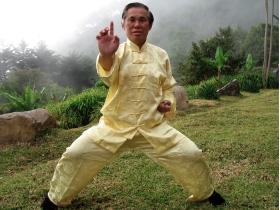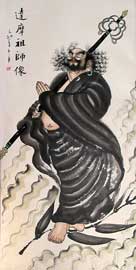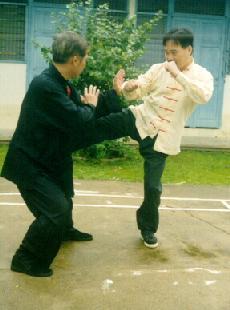SELECTION OF QUESTIONS AND ANSWERS
NOVEMBER 2012 PART 1

Sitting meditation
Question 1
What is the difference in terms of method and benefits between Buddhist meditation nowadays and sitting meditation used in Kungfu?
— Jason, Malaysia
Answer
First of all let us be clear of the terms used. Buddhist meditation is the form of meditation used in the Buddhist tradition, and sitting meditation used in kungfu is the form of meditation used by kungfu practitioners in a sitting poise.
If we accept these two definitions, then all sitting kungfu meditation in Shaolin is Buddhist meditation as Shaolin follows the Buddhist tradition. On the other hand, not all Buddhist meditation is sitting kungfu meditation, as there is a lot of Buddhist meditation for non-combat purposes.
It is important to clarify that the term "Buddhist tradition" here does not make it religious. The term "Buddhist" is used in its purest sense, meaning following the teaching of the Buddha. And the Buddha means the Enlightened One.
To Christians, the Enlightened One is Jesus, or to many Catholics, she is Saint Mary. To Muslims, the Enlightened One is Prophet Mohammed. To many Shaolin practitioners, the Enlightened One is Bodhidharma. It is worthy to note that throughout centuries there were Taoist, Christian as well as Muslim masters at the Shaolin Temple.
Returning to your question, we may narrow down the definition of Buddhist meditation to mean sitting in a lotus position to investigate into Cosmic Reality, and kungfu sitting meditation to mean sitting in a lotus position to develop internal force for better kungfu performance.
Using these refined definitions, we shall be in a better position to differentiate the methods and benefits in these two forms of meditation.
Although the outward form is the same, there are many different methods used in and many different benefits derived from these two forms of meditation. I shall only touch on the main methods and benefits.
There are two main methods in Buddhist meditation, called concentration and contemplation. These two methods or approaches, though can be used independently, are often used consecutively. First, an aspirant concentrates his mind to be one-pointed, then he employs his one-pointed mind to contemplate on Cosmic Reality, asking question like "Who am I? " and "What is Reality?".
The countless benefits of Buddhist meditation can be classified into three levels. At the basic level, practitioners are peaceful and relaxed. At the intermediate level, their mind is fresh and sharp, enabling them to attain peak performance. At the highest level, they experience expanding into the Cosmos and eventually Enlightenment.
There are also two main methods or approaches in kungfu sitting meditation, namely focusing on one and expanding into zero. When a kungfu practitioner has attained a one-pointed mind, he can use it to achieve various kungfu abilities, like activating the Small Universe or Cosmos Palm. When he has expanded into the Cosmos, he can develop tremendous internal force, like Golden Bell and One-Finger Zen.
The many different kungfu benefits can also be classified into three levels. At the basic level, practitioners are relaxed yet powerful and their movements are precise. At the intermediate level where their mind has expanded beyond their body, they can often pick up not only the movements but also the intentions of their opponents before the opponents execute them. At the highest level, they become formless; they can handle opponents as if effortlessly.
There is a great advantage we in Shaolin Wahnam enjoy but other people may not. Because we have a clear understanding between techniques and skills, and between form and non-form, the skills derived from our kungfu meditation can also be applied, often without our conscious effort, to benefits of Buddhist meditation. In other words, we are also be peaceful and relaxed, attain peak performance, and experience expanding into the Cosmos.
Question 2
I attended an introductory Zen meditation session organized by a Buddhist temple. During the sitting, my attention was brought to my eyes, upper head and forehead. I didn't mean to put my attention there, but instead my attention was brought to these area.
I also experience this when practicing horse-riding stance. It makes me wonder whether there is a difference between sitting meditation and stance training. I also wonder whether sitting meditation generates internal force just like the way we use stance training or One-Finger Shooting Zen.
Answer
It was probable that in both your Buddhist meditation and your stance training, you shifted your mental focus to your upper body, resulting in sensations there. Ideally, your focus should be at your dan tian.
Hence, many practitioners in Buddhist meditation as well as stance training, place their mind at the dan tian. Even if we do not consciously do this, when we are totally relaxed, the focus will naturally be at the dan tian, as it is not only the physical but also the energetic and spiritual centre.
Yes, there are differences between sitting mediation and stance training. Of course, the physical difference in outward form is obvious. Relatively, the energy is focus at the base at the hui-yin point in sitting meditation, whereas in the Horse-Riding Stance the energy is focused at the qi-hai point at the middle dan tian.
Spiritually, the purpose of sitting meditation is to let the energy rise up the spine and open the bai-hui point at the top of the head to release the spirit, as in yoga and Taoist meditation. In Buddhist meditation the mind becomes so clear that ignorance dissolves and the aspirant attains Enlightenment. In stance training, the purpose is to develop mental clarity and internal force to enhance combat efficiency as well as daily living.
Sitting meditation also generates internal force, but it is little compared to what we gain in stance training or One-Finger Shooting Zen. Relatively speaking, meditation focus on mind (or spirit), whereas stance training and other internal force training methods focus on energy.

One-Finger Shooting Zen
Question 3
Two years ago when I thought on my dan tian, I felt chi "burst" gently from my dan tian. Later, apart from expanding, my attention was brought to my forehead. And now apart from these, I feel there is something on my crown, hovering above it. The body is like going to evaporate up to the sky.
Answer
The practical answer is don't worry, don't intellectualize, just enjoy your practice.
The academic answer is that you have attained the second level of converting qi to shen, or converting energy to spirit.
There are three levels of attainment in any internal cultivation:
- Transforming jing to qi, or form to energy
- Transforming qi to shen, or energy to spirit
- Returning spirit to the Great Void
Although it is the second of the three levels, in today's situation transforming qi to shen is a great achievement that even masters may not attain.
What are its benefits? You can find the answer from your daily life, like being peaceful and happy everyday, and having a lot of mental clarity and energy to carry on your daily life.
Question 4
What is the purpose of sitting meditation as we already get great benefits from dynamic chi kung exercises and other force training exercises?
Answer
This is an excellent rhetoric question. It answers the questions many people, including some of the masters in our school, have asked me, like why don't I teach sitting meditation or when will I teach sitting meditation?
Not only we have attained all the benefits of sitting meditation, but also we have attained them in a far shorter time!
Why do people practice sitting meditation?
There are three main reasons, according to three main developmental stages:
- To be relaxed, peaceful and happy.
- To have mental clarity.
- To attain spiritual fulfilment.
If a cultivator after five years meditating everyday in a temple, experiences his spirit expanding into the Cosmos, it would be a fantastic achievement. He would kiss the feet of his teacher.
Yet, ridiculous in a good sense, many students have such spiritual experiences in my intensive or even regional courses!
On the other hand, there are a few members of our school who have persistently asked me to teach sitting meditation, forgetting that ours is a kungfu and chi kung school, not a retreat centre for people, dreamingly, to attain nirvana over a summer vacation.
Some of these same people, despite being in our school for many years, cannot comfortably handle a black-belt in free sparring or have the mental clarity to distinguish between prejudice and reality. They would do better to focus on the great variety of training we already provide to enrich their daily life than to dream of sitting meditation to reach nirvana.
Editorial Note
: Jason's other questions will be posted in the
November 2012 Part 2
issue.

Was Bodidharma a Chinese?
Question 5
Thanks very much for your reply. I think we have a problem. When I called you a few weeks ago and explained my question to you and told you about my friend I understood you to say, "Good. Yes, you can continue, but gently."
I am so very sorry if I misunderstood. The question now is, what should we do? She is practicing and seeing benefit, as are three other friends.
I await your word on this, and I am truly sorry for any mistakes I may have made.
— Mary, Galapagos Islands
Answer
I am sorry for the confusion.
Actually the message in both the telephone conversation and the e-mail is the same. The fundamental principle is to teach your friends in a way that benefits them but not causes them any insidious harm.
The question is where the safety line to be. If you teach them gentle physical exercise, which will also bring them benefits, it is safe. If you teach them chi kung, especially like the level you experienced at the Intensive Chi Kung Course, it is risky. So, at what area should you teach. It is always better to err on the side of safety.
Let us mark the range from 1 to 10, 1 being very safe, 10 being very risky, and 5 being the mid-point. Don't teach at 5, not even at 4. Teach at 2, progressing to 3, leaving 2 marks as buffer for safety.
If your friends are having benefits, continue as you have been doing. Congratulations.
Question 6
Only after coming back to Malta I realized that you were in Spain as well. Still something happened whilst I was in Spain because a desire came that I need to take my Shaolin Arts to the next level by attending the Intensive Courses in Malaysia. I am doing my best to put together the money to come to Malaysia in July this year since I had some other financial commitments. I wish to attend both the Chi Kung and Kung Fu courses but if I don't manage to do both I will attend the Chi Kung course as a start.
— Sifu Claudien Scicluma, Malta
Answer
Co-incidents don't really happen.
I was just explaining in the Iron Wire course in Barcelona about the difference between drain and flow. For most other people, when they exert force in a strike or in sparring, they drain their energy, i.e. they become tired after the strike or sparring.
But in our case, it is a flow, i.e. we become more energetic after the strike or sparring because as energy flows out, fresh energy flows in. As the out-flow is vigorous as in a strike or sparring, it enlarges the flow, which results in more energy flowing in than flowing out. Hence, we end up with more energy than before the strike or sparring.
I also related this to economic life. For most other people, when they spend some money beyond their normal level, they end up with less money. But for us, when we spend some money beyond our normal level, we activate a larger flow. Initially we have less money. But soon more money flows in.
For example, if our students earns 3000 per month and spends 2800, he saves 200 per month. He will continue earning 3000 and saving 200 every month if he maintains his normal expenditure.
If for some reasons he increases his expenditure to 3500 per month. Initially he may have to borrow money from somewhere. But eventually he will earn 4000 per month and saves 500.
Of course this does not mean that he can spend money carelessly. But if he increases his expenditure wisely, he activates a bigger in-flow.
This is how people as well as nations become rich -- not by thrifty spending and saving, but by enlarging both the out-flow and in-flow.
Many students as well as instructors reported that this was actually what happened. They borrowed money to come to my courses. But after returning home, they had financial difficulty at first but soon they found that their income increased quite remarkably.

Kungfu is for fighting
Question 7
Chinese masters are known to be conservative, but you are so generous with your teaching. Did you face any opposition from other masters when you first taught to the public? How did you deal with these oppositions?
— Sifu Daniel Perez, Spain
Answer
Yes, I faced a lot of opposition, especially when I first taught to non-Chinese.
Most of the opposition was behind my back. Some was made in front of me, but still in a polite manner. This was because by the time I taught to the public I was very senior in my lineage as I started learning kingfu as a small boy, and also I had built up a good reputation.
I could handle these oppositions quite easily. I used three strategies, in progressive order.
At that time kungfu masters were in the habit of saying "fatt yeong kong tai", which means "let us spread kungfu and make it prosper everywhere", especially at a time when they felt threatened by Karate and Taekwondo, and following the example of the celebrated Bruce Lee.
So all I had to do was to ask my distracters how they could spread kungfu and let it prosper if they kept its secrets. They often answered that we could teach kungfu forms but kept the kungfu secrets.
I would say that that was not spreading kungfu but debasing kungfu. That was the reason why typical kungfu students were no match against Karate and Taekwondo students. I had to be very careful in stating this fact so as not to hurt the sensitivities of the distracters as they were often the masters guilty of this deterioration.
This usually stopped their opposition, but for the few who still opposed me teaching non-Chinese, I would ask them who the First Shaolin Patriarch was and whether Bodhidharma was Chinese.
On rare occasions where opposition still persisted, I would use my most powerful strategy. I would ask in a pleasant way whether they would want a free sparring with me. I was known to be a good fighter, and this would end all argument. It was not logical, but convention was such that if you could beat them in free sparring, they would not argue with you. After all, kungfu was for fighting.
Question 8
It is generally accepted that it takes many years to practice an internal art. But your courses take only a day, or sometimes a few days. Can you please elaborate on this?
Answer
It is unthinkable that my courses on internal arts last only a day, or at most a few days. Twenty years ago I would not believe this was possible. Hence, it is understandable why many people do not believe in what we claim, and some call me a liar.
But what puzzles me is why these sceptics do not take a course to find out for themselves. We are so ridiculously generous, we open such courses virtually to anybody, and with a money-back guarantee if they are not satisfied. We do so because we genuinely want to preserve the internal arts.
Twenty years ago, I would gladly pay ten times the fee to attend such a course, even without a money-back guarantee. I would rather be a fool for a day, or a few days, and lose some money, rather be a fool for life.
Why is it that students could experience internal force in a course of a day? It is because I transmit the necessary skills to them and systematically lead them to develop internal force.
In the past internal art training was unsystematic. A teacher would teach a student a technique, after the student had proven himself over many years to be worthy of the art. The student would practice the technique over and over again for at least a few months before he could develop a needed skill.
Then the teacher would teach the student another technique. The student would again practice for a few months to develop another needed skill. Only when the student had developed the required skills, his internal development really began, and this might be many months or years after he learned his first technique.
Usually both the teacher and the student were not aware of the difference between skills and techniques. This ignorance greatly prolonged the time for the internal development. They thought, wrongly, that if one practiced the techniques long enough, he would acquire the internal art.
LINKS
Selected Reading
- Is it Not True that there is Only One Truth and One God?
- Kungfu Form, Kick-Boxing and Chi Kung
- Opening the Third Eye
- 108-Pattern Yang Style Taijiquan
- South to Old Smoky
